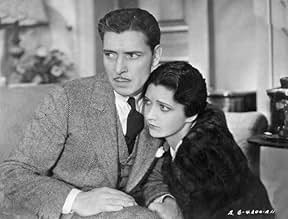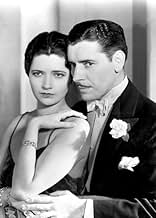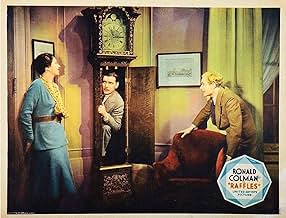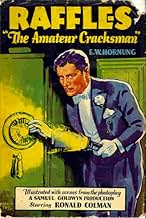Raffles
- 1930
- 1h 12min
Agrega una trama en tu idiomaA distinguished English gentleman has a secret life--he is the notorious jewel thief the press has dubbed "The Amateur Cracksman". When he meets a woman and falls in love he decides to "reti... Leer todoA distinguished English gentleman has a secret life--he is the notorious jewel thief the press has dubbed "The Amateur Cracksman". When he meets a woman and falls in love he decides to "retire" from that life, but an old friend comes to him with a predicament that entails him com... Leer todoA distinguished English gentleman has a secret life--he is the notorious jewel thief the press has dubbed "The Amateur Cracksman". When he meets a woman and falls in love he decides to "retire" from that life, but an old friend comes to him with a predicament that entails him committing one last job.
- Dirección
- Guionistas
- Elenco
- Nominado a 1 premio Óscar
- 2 premios ganados y 1 nominación en total
- Lord Harry Melrose
- (as Frederic Kerr)
- Lord Melrose's Butler
- (sin créditos)
- Harry - Lord & Lady Melrose's Friend
- (sin créditos)
- Gwen's Friend
- (sin créditos)
- Party Guest
- (sin créditos)
- Dirección
- Guionistas
- Todo el elenco y el equipo
- Producción, taquilla y más en IMDbPro
Opiniones destacadas
Raffles is a celebrated cricket player and as such has entrée into all the proper British upper class homes of the between the two World Wars period. He also has an interesting sidelight as a thief, in his own way, admired even by the police for his skill at his craft as Cary Grant in To Catch A Thief.
Colman has made up his mind to steal a valuable necklace from Alison Skipworth, but a rather nasty complication sets in in the person of Bramwell Fletcher a friend who seems to have written a check for far more funds than he has. Fletcher attempts suicide at Colman's apartment and Colman says he'll help.
In this very short, barely over 70 minute feature film, Colman has the unusual task of, accomplishing his objective in stealing the necklace, avoid detection by the police in the person of amiable Scotland Yard Inspector David Torrence, help poor Fletcher out with his problem, and last, but certainly not least win the love of long time girl friend, Kay Francis.
In a very cleverly written script Colman does accomplish nearly all, but the strength of Raffles is the telling of the tale of how he managed it all. Let's say that Colman is one clever guy who thinks very fast on his feet.
Despite the well chosen supporting cast by Sam Goldwyn, Raffles is a film held together by the charm and personality of Ronald Colman. Much the same way as the 1939 version of Raffles that Goldwyn did is held together by David Niven.
And if you're a Ronald Colman fan who like I could listen to him recite the Erie County Phone Directory, than Raffles is an absolute must for you.
In the 1939 version, maybe because of the code, Raffles is a Robin Hood type who robs for the excitement and fun of it but then helps someone in need with the money or returns the merchandise. In this version, he steals, period, and in fact presents Gwen with a bracelet from one of his crimes. This film skips the whole beginning of the '39 film showing Raffles' acts of kindness, but the rest of the story is the same. Raffles decides to retire and start life anew with Gwen, but his friend Bunny shows up with a gambling problem and needs to cover a 1000 pound check by Monday. Raffles, alas, needs to do one more job.
Ronald Colman is delightful as Raffles, dashing, charming, and handsome as he cleverly attempts to escape the clutches of Scotland Yard. It's a wonderful role for him, as it was for David Niven in 1939. Kay Francis is wasted but is a good match for Coleman.
Fun film with a fine performance by Colman.
Raffles the English gentleman has a discreet sideline as a burglar and jewel thief. The press has dubbed him 'The Amateur Cracksman', and as such he has become a household name. Now that he has fallen in love with the sophisticated Gwen (Kay Francis) and proposed marriage to her, Raffles has decided to retire from crime. However, his old pal Bunny is in a spot of bother. Bunny has been playing cards again, and has run up a gambling debt of £1,000. If Bunny is to be rescued from his predicament, Raffles will have to take on the Melrose 'job' ...
Ronald Coleman gives us his trademark suave Englishman in the title role. We see him burgling a jeweller's shop wearing a top hat (note the excellent Toland touch of the policeman silhouetted against the window drape). Our first real glimpse of the hero comes on the dance floor as he sweeps Gwen around in a romantic waltz. On the cricket field at Lord Melrose's place, Raffles is of course dashing, and wins the game (even though he was not supposed to be playing - he invited himself along for the weekend at the last minute). Even when Inspector Mackenzie has him on the ropes, Raffles remains the epitome of poise and wit.
"All bubbles and froth - no taste," says Lord Melrose, giving his verdict on champagne. It is a reasonable comment on the film itself, which for all its pretensions to style is basically an inelaborate crime flick. We have the 'two Englands' crudely juxtaposed - one urban and ugly (the cloth-capped burglars from the pub, the 'pea soup' fog in London) and the other bucolic and 'refayned' (Lady Melrose's soiree). The film takes it for granted that the lower classes are unpleasant.
However, there are good things in this movie. The cricket match is fun, and tolerably well done, though Raffles' bowling action is highly dubious and the umpire's position would make lbw decisions interesting to say the least. The skylight scene on Raffles' apartment roof is an arresting image.
There is also a large portion of baloney. Does Scotland Yard protect country houses against burglary? Is this best done by surrounding them with a dozen detectives throughout the night? Why don't these detectives catch the various burglars who enter the premises? If closing the sash window is enough to stop the burglar alarm from ringing, then it isn't much of a burglar alarm. The 'common' burglars crouch in the shrubbery and talk aloud, spelling out their plans in pedantic detail, conveniently allowing Raffles to overhear. Is it not slightly more probable that they would have worked out what to do before entering the property?
The film ends in a flurry of increasingly silly activity. Blatant undercranking of the camera makes Raffles' escape dash look ridiculous, and his place of concealment is laughable.
Verdict - An enjoyable crime caper with absurd elements.
Moreover, as another character chimes, one, indeed, can't help liking Colman's Raffles. The supporting cast is decent, too, including Kay Francis as the romantic interest, David Torrence as the Scottish Scotland Yard inspector, and Alison Shipworth and Frederick Kerr are amusing as the bickering hosts to their home of guests spending the weekend, apparently, smoking, drinking and playing cricket and tennis--the sort of upper-class soirées one might expect from an episode of "Downton Abbey," where dandies in tuxedos sip brandy and retort that Americans are too savage to understand cricket.
I think what raises "Raffles" above many other early talkies, however, is the talent Samuel Goldwyn assembled behind the scenes, namely cinematographers George Barnes (5-time Oscar nominee) and Gregg Toland (who also photographed the 1939 version and is most famous for "Citizen Kane" (1941)) and art directors Park French and William Cameron Menzies (the latter of whom would invent the job of production designer during the making of "Gone with the Wind" (1939)). There's nothing amateurish in their design of the amateur cracksman's first heist scene, with the policeman's shadow lurking in the background behind store-front glass as a safe is cracked with the aid of a diegetic light source. Some camera movement is managed, too, including a nice shot of Colman on the staircase upon seeing Francis's entry. Being England, there's also a fog-filled sequence. There's nothing amazing about any of this, but it's worth noting how much difference to a slight scenario burdened by primitive new technology can benefit from skilled artists behind the camera while placing charming actors in front of it, as well as giving some thought to how to use and not use the newfangled sound.
"Raffles" is about a gentleman who is also an amateur thief--and a very talented one. While his society friends adore Raffles (played by Ronald Colman at his charming best) because of his wit, sporting skills and fine manners, they don't realize HE is this thief. Much of the film concerns his attending a particular weekend party in order to steal a necklace so he can use the money to help a friend in dire straits. However, along the way he meets up with a swanky lady (Kay Francis) and he's torn between his life of crime or becoming 100% legitimate for her sake. What will Raffles do? And what will Raffles do when ANOTHER crook shows up as well?! All in all, "Raffles" is a pleasant and a bit too talky film. Personally, I think it would have been better with more outdoor scenes and action. But again, 1930 was still a transitional year for sound and the stagy production was pretty typical. I also thought Raffles' 'brilliant' escape at the end was anything but. However,the acting was good and it was nice to see a detective who was NOT stupid (a common and rather dumb cliché of the 1930s and 40s). Well worth seeing but not among Colman's best work.
¿Sabías que…?
- TriviaThe last Samuel Goldwyn movie to be shot simultaneously in silent and talkie versions.
- ErroresWhen the alarm goes off and the cat burglar is attempting to escape, Bunny's bedroom windows are show to be wide open, which would have prevented the alarm being set in the first place.
- Citas
Inspector McKenzie: Good heavens! In the tobacco! Well, I'll be...
A.J. Raffles: Yes, I thought that you would be.
- Versiones alternativasRaffles (1930) was made simultaneously in silent and talking versions. With almost all the theaters in the USA wired for sound, this was to be the last film that Samuel Goldwyn produced in this manner.
- ConexionesReferenced in The Devil Is a Sissy (1936)
- Bandas sonorasThe Blue Danube
(uncredited)
Written by Johann Strauss
Heard when Raffles takes Lady Melrose to her room.
Selecciones populares
- How long is Raffles?Con tecnología de Alexa
Detalles
Taquilla
- Total en EE. UU. y Canadá
- USD 1,000,000
- Tiempo de ejecución1 hora 12 minutos
- Color
- Mezcla de sonido
- Relación de aspecto
- 1.20 : 1
Contribuir a esta página

































